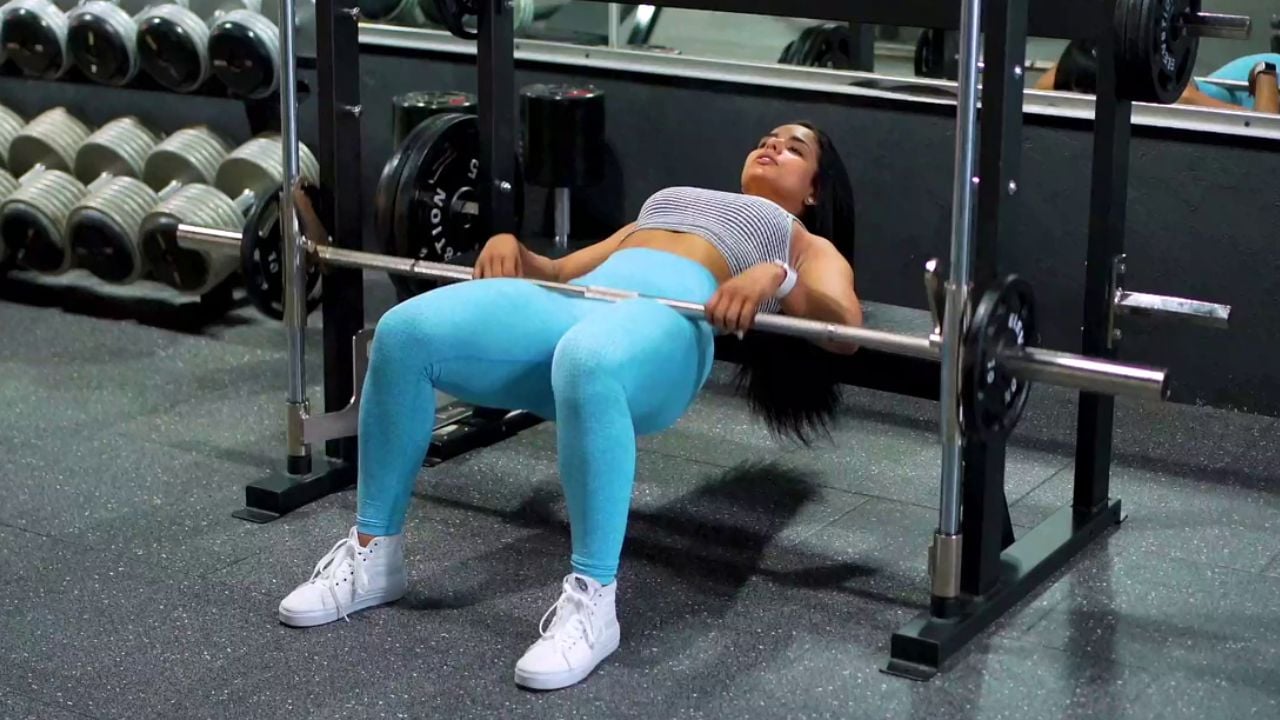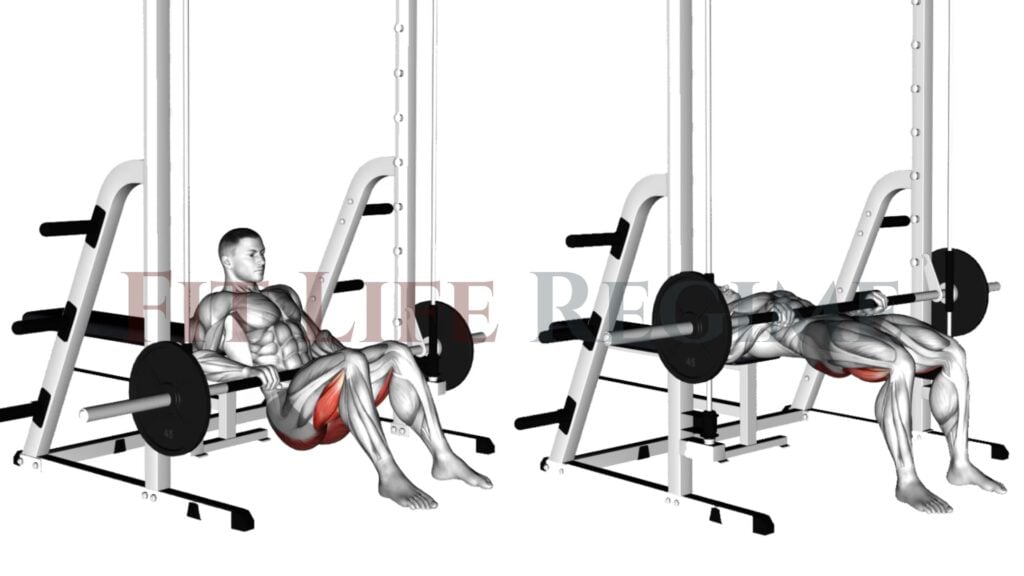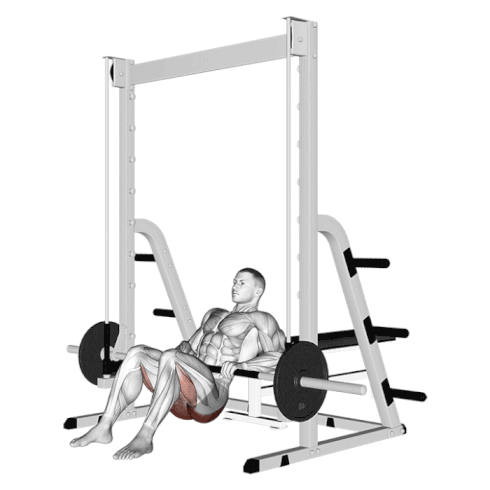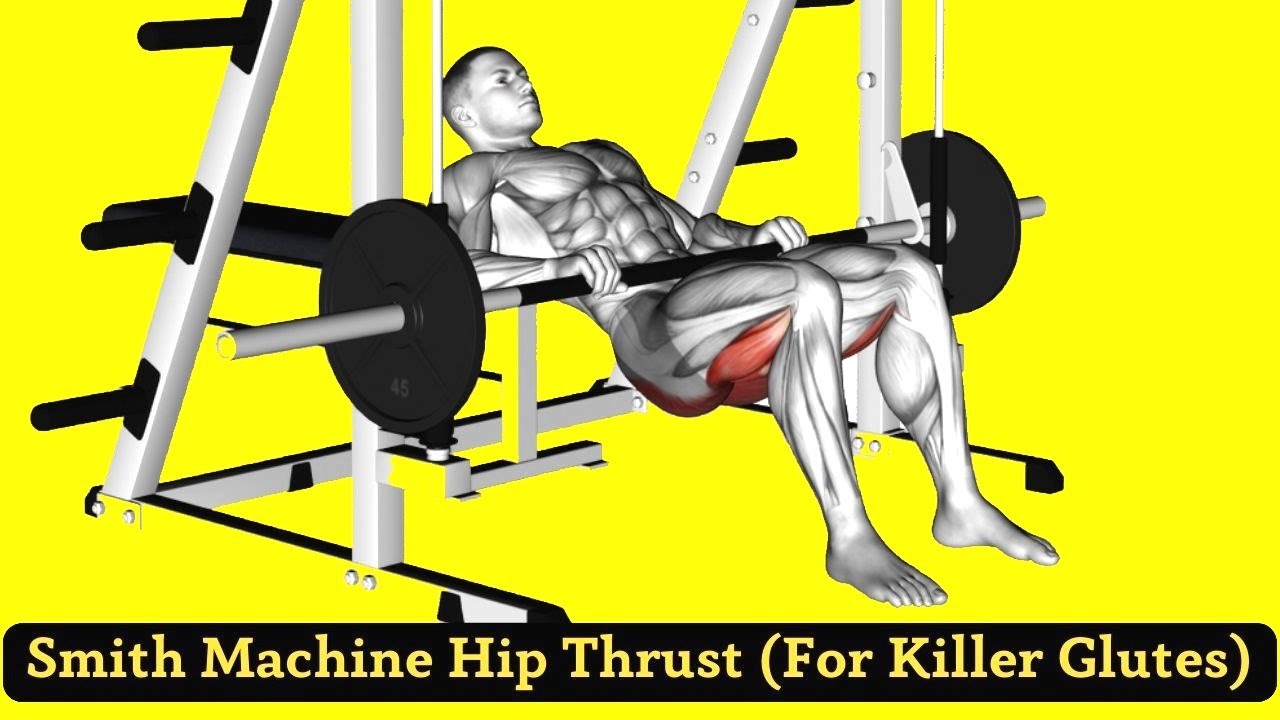Tired of squats and lunges just not delivering the glute results you crave?
Transforming your glutes from flat to fantastic doesn’t have to be complicated.
The Smith Machine Hip Thrust is your secret weapon, helping you unlock serious glute gains.
Get ready to feel that glute burn as we cover this exercise’s how-to, why, and WOW factors.

What is Smith Machine Hip Thrust
The Smith Machine Hip Thrust is a variation of the traditional barbell hip thrust.
The exercise is done on a Smith machine with a self-balancing barbell with guide rods, so you can focus on lifting the weight and don’t need to balance it.
It is a targeted strength-training exercise designed to strengthen the glutes, hips, and lower back.
Unlike traditional barbell hip thrusts, the Smith Machine version offers increased stability and safety due to its locked vertical track system.

Know More: 12 Most Effective Smith Machine Leg Workout & Exercises
Muscles Worked During Smith Machine Hip Thrust
The Smith Machine hip thrust primarily targets the muscles of the lower body.
The primary muscles worked during the Smith machine hip thrust are:
- Glutes (Gluteus Maximus, Medius, and Minimus)
- Hamstrings
The secondary movers and stabilizers are:
- Quads
- Lower back
- Abdominals and Obliques
- Hip Adductors
Want to take your gains to the next level? Discover your daily calorie needs with our free TDEE calculator
How to Set Up and Do Hip Thrust on Smith Machine
While the Smith Machine offers a guided movement pattern, understanding proper technique is still essential for maximizing results and preventing injuries.
A sloppy setup or incorrect form can seriously undermine your progress.
So, let’s get your station dialed in! Setting up the Smith Machine for hip thrusts is simple:
- Find a sturdy bench that will support your shoulder blades.
- Place a bench horizontally in front of the Smith Machine.
- Sit on the ground with your upper back leaning against the bench.
- Your shoulders should be firmly positioned on the bench, and your feet should be flat on the floor and hip-width apart.
- Slide your body underneath the bar of the Smith Machine so that the bar rests directly above your hips.
- Place a mat or barbell pad where the bar rests on your hips for extra cushioning (added comfort).
- Grip the bar with both hands, using an overhand grip.
- Lower the Smith Machine bar to a comfortable starting height.
- If you’re too high up the pad, you won’t have room to thrust fully.
- So, It should be low enough to get into position easily but high enough to lift and lower the weight safely.
- Carefully position the bar rests across the crease of your hips.
- Press through your heels and drive your hips upward.
- Squeeze your glutes tightly at the top of the movement to maximize muscle activation.
- Lower your hips back down towards the ground slowly and calmly.
- If using weights, carefully add the desired weight plates to the Smith Machine bar.

Tips and Form
- Place your feet shoulder-width apart, heels firmly planted on the ground.
- Your toes can slightly point outwards for stability.
- Maintain a neutral spine throughout the entire movement. Avoid arching or rounding your lower back.
- Ensure the pad or towel is securely positioned on the bar to prevent.
- At the starting position, initiate a slight posterior pelvic tilt (tucking your tailbone under slightly) to help engage your glutes.
- Experiment with different tempos (e.g., slow reps, paused reps at the top) to increase the challenge.
- Exhale as you drive upward, inhale as you lower the weight.
- Use a full range of motion: thighs should be parallel or below at the bottom.
- Don’t just rely on explosive reps. Try to slow down the lowering phase.
- Try different foot positions – toes pointed slightly more outward or closer together. These small tweaks can target your glutes in slightly different ways.
Modifications and Variations Of Smith Hip Thrust
1. Single-Leg Hip Thrusts
Perform the hip thrust with one foot elevated off the ground, focusing on one leg at a time. This variation increases stability and unilateral strength while targeting each glute individually.
1. Foot elevation
For this variation, you would place your feet on plates or a low, stable step. Here’s why it works:
- Higher feet allow for a deeper descent, stretching and engaging the glutes even more than the standard setup.
- More range of motion means more time under tension for your glutes.
3. Resistance Bands
Looping a resistance band around your knees (and possibly anchoring it to the Smith Machine at a low point, depending on your band’s length) will bring some extra spice to the exercise. Here’s how:
- The band will provide you with the greatest resistance as you reach the movement’s top.
- Bands work differently than regular weights, making them harder and possibly working your muscles differently.
4. Tempo Changes
Altering the speed of your reps can significantly change how the exercise feels. Here are some ideas:
- Paused Reps: Hold the contracted position at the top of the movement for 1–3 seconds.
- Slow Negatives: Take 3–5 seconds to lower the weight. This puts more focus on the eccentric (muscle lengthening) portion of the exercise.
To Stay Motivated: 150+ Gym Workout Motivational Quotes To Stay Fit
Conclusion
In the world of glute training, the Smith Machine Hip Thrust reigns supreme.
Remember, mastering your form and understanding the variations will help you reap the maximum rewards.
Now, let’s get to work! Try out the tips discussed in this blog, and let me know how your next glute day goes.
Share your experiences and tips in the comments below – let’s learn and grow together!

Manish is a NASM-certified fitness and nutrition coach with over 10 years of experience in weight lifting and fat loss fitness coaching. He specializes in gym-based training and has a lot of knowledge about exercise, lifting technique, biomechanics, and more.
Through “Fit Life Regime,” he generously shares the insights he’s gained over a decade in the field. His goal is to equip others with the knowledge to start their own fitness journey.

